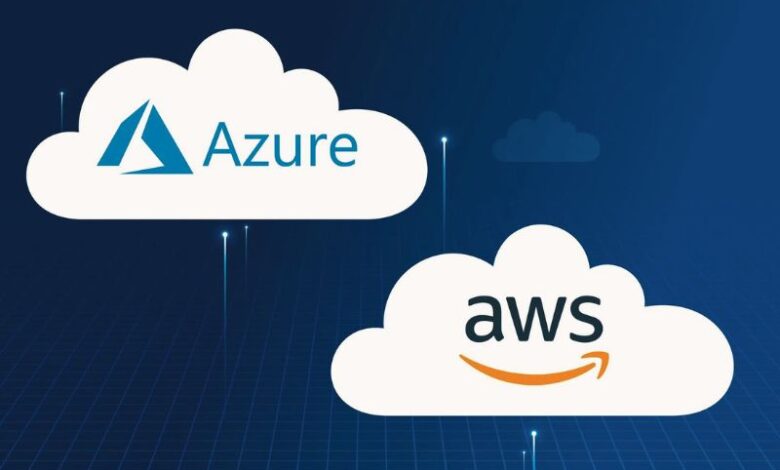Cost Optimization Guide: SQL Server on Azure vs AWS

Which Cloud is Cheaper for Hosting SQL Server Databases: Microsoft Azure or Amazon Web Services?
Migrating business-critical databases like SQL Server to the cloud can provide great flexibility, scalability, and potential cost savings.
The two most popular public clouds, Microsoft Azure and Amazon Web Services (AWS), both offer managed SQL Server options.
But which provides the most budget-friendly SQL Server hosting for your needs? Let’s dive in!
Understanding SQL Server Licensing
SQL Server licensing on Azure works just like it does on on-premises servers. You pay a base rate per physical CPU core that the database uses along with a discounted rate per virtual CPU core.
Through Azure Hybrid Benefit (AHB), you can use any existing on-premises SQL Server licences with this architecture.
With AHB you can save up to 55% on virtual machine costs by reusing licenses.
Hire SQL server developer, AWS takes a separate “pay-as-you-go” strategy. Rather than licencing individual CPU cores, you pay per hour based on the size of the Amazon Relational Database Service (RDS) database instance you provision.
The main advantage of the AWS approach is you avoid large upfront license costs, paying only for what you use hourly.
This can provide significant savings for development, testing, and intermittent databases.
But for full production environments with consistent CPU and memory needs, the accumulating hourly charges can end up costing more long-term.
The ability to carry over existing licenses to Azure via AHB provides better TCO at scale.
Performance Efficiency and Scalability Architecture
In addition to how the database licenses are charged, the performance and scalability capabilities provided impact cost efficiency.
SQL Server licensing costs quickly add up if you aren’t able to make full use of the vCPUs available.
Azure offers a purpose-built series of VMs optimized specifically for workloads like SQL Server in the Mv2 and Msv2 families.
These instances deliver predictable baseline CPU performance and memory bandwidth not impacted by other workloads on the same hardware.
Azure also enables you to scale up to thousands of vCPUs on a single VM along with autoscaling capabilities.
AWS provides similarly optimized R5, R5d, and z1d instance families for SQL Server now.
But in general, Azure has more flexibility to tune VM configurations precisely to your database’s needs.
This helps improve compute efficiency and increase consolidation ratios to reduce overall licensing costs.
Database Platform Scalability and Automation
In addition to scaling up VM sizes, the ability to scale out databases efficiently over many VMs impacts cost as well.
SQL Server on Azure offers enhancements like elastic pools to allocate resources across hundreds of databases and scale them together.
Intelligent auto-tuning capabilities handle indexing and query optimization automatically.
With AWS RDS, you can scale up to multi-AZ deployments and provision read replicas for read-heavy workloads.
But overall database management requires more hands-on administration for efficiency.
RDS relies on manual monitoring and intervention to tune and consolidate database resource usage over time.
The automated resource optimization of the Azure SQL platform reduces overhead costs associated with managing and tuning databases.
The built-in smarts provide better utilization of the licenses you pay for.
Data Center Locations and Network Transfer Costs
The geographic footprint and bandwidth rates of a cloud platform also contribute to overall costs, especially for global deployments.
Azure offers cool access tier storage with over 80% cost reduction for infrequently accessed data along with free inbound data transfer.
Outbound data transfer is metered and billed per GB but is low cost in the context of total TCO. AWS provides 100 GB/month of outbound data transfer between regions for free, charging similar rates beyond that.
For massive data migrations, Snowball (AWS) and Data Box (Azure) provide physical transport mechanisms to avoid network charges altogether.
Overall Azure has a small edge in data storage and transfer costs thanks to the breadth of regions and cool-tier storage. But generally data network costs are reasonably similar between the two.
High Availability, Disaster Recovery and Backup Costs
Keeping SQL Server databases and data protected and always available adds costs on top of basic hosting fees.
Planning for redundancy, failover, and backup is key for business continuity.
Cloud platforms offer various high availability (HA), disaster recovery (DR) and backup capabilities, often for additional fees.
Native to Azure, SQL Server AlwaysOn Availability Groups can extend your on-premises environment to Azure.
This lets databases failover automatically for high availability during an outage.
Azure Site Recovery can replicate entire virtual machines (including SQL Server) to other data centres. This protects against a region-wide disaster.
AWS provides similar HA and DR options for SQL Server through RDS Multi-AZ deployments.
These mirror databases to standby instances in other zones.
You can also replicate full EC2 virtual machines across regions for DR, much like Site Recovery. The costs for core redundancy capabilities are fairly comparable.
A bigger cost difference arises for backups. Azure Backup gives one integrated service for safeguarding both VMs and SQL databases in Azure.
It offers centralized reporting and management for all backups. Features like compression and incremental snapshots reduce storage overhead.
AWS lacks an equivalent integrated backup solution. So you often end up needing additional third-party tools to manage and orchestrate SQL Server database backups.
These extra license and support fees add costs indirectly.
For near-real-time backup and restores, Azure recently added the ability to revert entire VMs in time up to 30 days.
AWS provides similar functionality by continually backing up EBS volumes, letting you roll back to any point within the backup retention window.
These “rewind” capabilities deliver extra flexibility for data recovery beyond just backups.
Cloud Management Efficiency and Automation
Saving time and effort on management and operations translated into lower overhead costs as well.
Azure Portal, Azure PowerShell/CLI, and tools like Azure Arc provide unified control planes across on-prem and cloud. AWS offers comparably diverse access through Console, CLI, SDKs and more.
But Azure shines brighter when it comes to built-in automation for SQL Server specifically.
Features like SQL Agent, Extended Events, and PowerShell tailored for databases all help reduce manual tasks.
The Azure Monitor service gives consolidated monitoring and alerting for VMs and databases.
AWS provides CloudWatch for base OS and application metrics, along with RDS Enhanced Monitoring for database visibility.
Overall the breadth of integrated tooling enables greater efficiency on Azure reducing human effort and the potential for configuration oversights that impact costs.
The unified view across hybrid infrastructure is also a plus.
Development and Test Environment Cost Management
For development, test, staging, and QA databases that don’t require production capacity or availability, there are cost optimization approaches as well.
AWS shines here with options like connecting test/dev environments easily to live production data through RDS Read Replicas to avoid copying large datasets.
Features like restoring snapshots to new accounts/regions help efficiently spawn parallel environments.
On the Azure side, leveraging PaaS services like Azure SQL Database for staging/test rather than provisioning full VMs and SQL instances can drastically cut costs.
Automated capabilities like SQL Data Warehouse staging help roll out new environments easily.
Shared dev/test labs provide centralized governance around spinning up resources.
And Azure Dev/Test subscriptions allow pooled resource allowances with billing caps across a team.
Overall AWS likely has an edge for more seamless replication of production data sets to downstream environments.
But with some planning and automation, Azure PaaS-based dev/test can achieve similar results at even lower costs by skipping the overhead of managing infrastructure entirely.
Hybrid and Multi-Cloud Cost Containment
In large enterprise contexts, Multi-cloud and hybrid on-prem/cloud deployments are common for risk mitigation. But this doubles the cloud attack surface posing cost management challenges.
AWS and Azure both provide cloud migration cost analysis tools to right-size workloads and estimate TCO differences.
Azure Arc extends on-prem management and security controls to AWS and other clouds via consistent policy across environments.
Azure Lighthouse allows centralized monitoring and access controls across all infrastructure and services regardless of region or cloud provider, streamlining operations.
For true multi-cloud database architectures, technologies like SQL Server Integration Services (SSIS) simplify moving, transforming and consolidating data across platforms reducing duplication.
Azure Data Factory and AWS DMS provide complementary data integration and workflow orchestration as well.
Generally Azure has more mature hybrid/multi-cloud management capabilities to reduce the overhead of complex architectures.
However, a mix of both cloud vendors’ tools can cover more scenarios for data and workload movement that is efficient cost-wise.
Long-Term Total Cost of Ownership (TCO) Analysis
For the most accurate financial comparison between running SQL Server on Azure versus AWS, conducting a detailed Total Cost of Ownership (TCO) analysis is highly recommended.
A TCO analysis projects expected costs over a 3-5-year period based on estimated usage levels and infrastructure needs.
This longer-term perspective provides a more realistic model than just looking at upfront instances or licensing fees in isolation.
Both Azure and AWS cloud analytics provide online TCO calculators and cost management tools to assist with long-term projections and right-sizing.
With a SQL Server TCO analysis, key inputs would include the expected number of processor cores and memory required, storage needs and monthly growth, database transaction volumes, network egress traffic estimates, and high availability/disaster recovery requirements.
The TCO model accounts for the amortized cost of infrastructure over expected refresh cycles, including the savings from Azure Hybrid Benefit license reuse over time.
Additional Azure savings levers like reserved virtual machine instances and Azure hybrid benefits should be factored in as well.
On the AWS side, TCO scenarios should evaluate RDS reserved instances and Savings Plans which can reduce compute costs by up to 72% if workloads and sizes are predictable.
The analysis can also compare the cost of manual database administration and tuning over time vs the savings from automated tuning advisors and intelligent optimization on Azure SQL platforms.
Scenarios should weigh the eye-opening cost of potential downtime against high availability configurations on each cloud.
Beyond quantifiable infrastructure and database costs, TCO can evaluate softer factors like technical debt to switch platforms, data gravity pull to keep databases localised to existing apps and pipelines, opportunity costs around accelerating projects, and more.
The depth of Azure integration with on-premises identity, security, and management components provides strong incentives to centralise SQL platforms there.
However, a balanced TCO avoids over-committing to a single vendor or platform, retaining the flexibility to evolve the architecture over time.
The TCO insight exists not primarily to pick a “winner” but to provide data-driven narratives for executives that capture the nuances and avoid oversimplification.
Even small tweaks like modifying the discount rate assumptions paint vastly different ROI pictures.
In the end, delivering the TCO model as an interactive tool with adjustable assumptions allows stakeholders to understand the “why” behind current platform decisions and cost optimizations made.
It enables planning iterations as workloads change in future years to keep costs continually fine-tuned for the organization’s needs.
The Verdict: Azure Cost Optimization Wins By a Narrow Margin
When all factors around licensing, performance, scalability, data management and automation are considered together, Microsoft Azure does come out ahead for cost-efficient SQL Server deployments vs AWS.
The pay-as-you-go hourly cost model of AWS RDS provides some advantages for more transient or unpredictable workloads able to leverage replication mechanisms to downstream environments efficiently.
However, the deeper integration and specialized enhancements in Azure make better use of the database licenses you provision over time, especially for production environments.
Planning for multi-cloud capability across both spreads risk and allows harnessing the unique strengths of each cloud that ultimately reduces TCO from a holistic perspective. Avoiding lock-in and maintaining room to fluidly evolve architectures keeps long-term costs most consistently optimized on balance.
What has your experience been with the relative costs of SQL Server on AWS vs Azure?
Which areas stood out as most impactful? Let us know in the comments.





